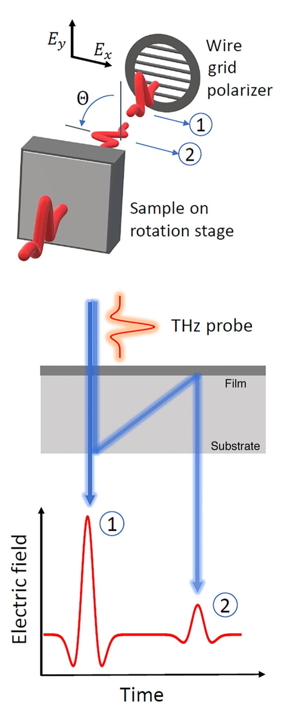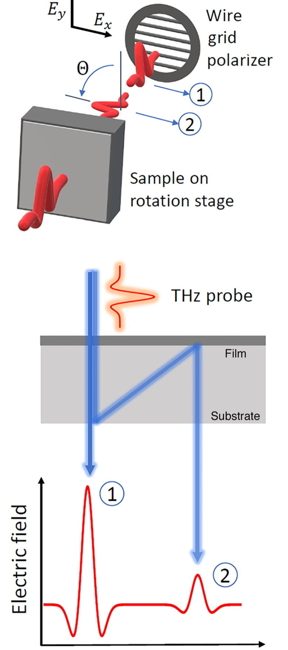Home > Press > Thin is now in to turn terahertz polarization: Rice labs discovery of magic angle builds on its ultrathin, highly aligned nanotube films
 |
| Rice University physicists have made unique broadband polarization rotators with ultrathin carbon nanotube films. The films optically rotate polarized light output by 90 degrees, but only when the input lights polarization is at a specific angle with respect to the nanotube alignment direction: the magic angle. (Credit: Kono Laboratory/Rice University) |
Abstract:
Its always good when your hard work reflects well on you. With the discovery of the giant polarization rotation of light, that is literally so.
Thin is now in to turn terahertz polarization: Rice labs discovery of magic angle builds on its ultrathin, highly aligned nanotube films
Houston, TX | Posted on May 20th, 2021
The ultrathin, highly aligned carbon nanotube films first made by Rice University physicist Junichiro Kono and his students a few years ago turned out to have a surprising phenomenon waiting within: an ability to make highly capable terahertz polarization rotation possible.
This rotation doesnt mean the films are spinning. It does mean that polarized light from a laser or other source can now be manipulated in ways that were previously out of reach, making it completely visible or completely opaque with a device thats extremely thin.
The unique optical rotation happens when linearly polarized pulses of light pass through the 45-nanometer film and hit the silicon surface on which it sits. The light bounces between the substrate and film before finally reflecting back, but with its polarization turned by 90 degrees.
This only occurs, Kono said, when the input lights polarization is at a specific angle with respect to the nanotube alignment direction: the magic angle.
The discovery by lead author Andrey Baydin, a postdoctoral researcher in Konos lab, is detailed in Optica. The phenomenon, which can be tuned by changing the refractive index of the substrate and the film thickness, could lead to robust, flexible devices that manipulate terahertz waves.
Kono said easy-to-fabricate, ultrathin broadband polarization rotators that stand up to high temperatures will address a fundamental challenge in the development of terahertz optical devices. The bulky devices available until now only enable limited polarization angles, so compact devices with more capability are highly desirable.
Because terahertz radiation easily passes through materials like plastics and cardboard, they could be particularly useful in manufacturing, quality control and process monitoring. They could also be handy in telecommunications systems and for security screening, because many materials have unique spectral signatures in the terahertz range, he said.
The discovery opens up new possibilities for waveplates, Baydin said. A waveplate alters the polarization of light that travels through it. In devices like terahertz spectrometers used to analyze the molecular composition of materials, being able to adjust polarization up to a full 90 degrees would allow for data gathering at a much finer resolution.
We found that specifically at far-infrared wavelengths — in other words, in the terahertz frequency range — this anisotropy is nearly perfect, Baydin said. Basically, theres no attenuation in the perpendicular polarization, and then significant attenuation in the parallel direction.
We did not look for this, he said. It was completely a surprise.
He said theoretical analysis showed the effect is entirely due to the nature of the highly aligned nanotube films, which were vanishingly thin but about 2 inches in diameter. The researchers both observed and confirmed this giant polarization rotation with experiments and computer models.
Usually, people have to use millimeter-thick quartz waveplates in order to rotate terahertz polarization, said Baydin, who joined the Kono lab in late 2019 and found the phenomenon soon after that. But in our case, the film is just nanometers thick.
Big and bulky waveplates are fine if youre just using them in a laboratory setting, but for applications, you want a compact device, Kono said. What Andrey has found makes it possible.
Co-authors of the paper are Rice graduate students Natsumi Komatsu and Fuyang Tay and alumni Saunab Ghosh, Takuma Makihara and Timothy Noe. Baydin is an Attwell-Welch Postdoctoral Fellow of Rice’s Smalley-Curl Institute. Kono is the Karl F. Hasselmann Professor in Engineering and a professor of electrical and computer engineering, of physics and astronomy and of materials science and nanoengineering.
The National Science Foundation and the U.S. Department of Energy supported the research.
####
About Rice University
Located on a 300-acre forested campus in Houston, Rice University is consistently ranked among the nations top 20 universities by U.S. News & World Report. Rice has highly respected schools of Architecture, Business, Continuing Studies, Engineering, Humanities, Music, Natural Sciences and Social Sciences and is home to the Baker Institute for Public Policy. With 3,978 undergraduates and 3,192 graduate students, Rices undergraduate student-to-faculty ratio is just under 6-to-1. Its residential college system builds close-knit communities and lifelong friendships, just one reason why Rice is ranked No. 1 for lots of race/class interaction and No. 1 for quality of life by the Princeton Review. Rice is also rated as a best value among private universities by Kiplingers Personal Finance.
Follow Rice News and Media Relations via Twitter @RiceUNews.
For more information, please click here
Contacts:
Jeff Falk
713-348-6775
Mike Williams
713-348-6728
Copyright © Rice University
If you have a comment, please Contact us.
Issuers of news releases, not 7th Wave, Inc. or Nanotechnology Now, are solely responsible for the accuracy of the content.
![]() Nanotubes line up to form films:
Nanotubes line up to form films:
![]() Department of Physics and Astronomy:
Department of Physics and Astronomy:
![]() Wiess School of Natural Sciences:
Wiess School of Natural Sciences:
News and information
![]() Researchers build structured, multi-part nanocrystals with super light-emitting properties May 28th, 2021
Researchers build structured, multi-part nanocrystals with super light-emitting properties May 28th, 2021
![]() Sensors developed at URI can identify threats at the molecular level: More sensitive than a dog’s nose and the sensors don’t get tired May 21st, 2021
Sensors developed at URI can identify threats at the molecular level: More sensitive than a dog’s nose and the sensors don’t get tired May 21st, 2021
![]() Luminaries: Steven DenBaars and John Bowers receive top recognition at Compound Semiconductor Week conference May 21st, 2021
Luminaries: Steven DenBaars and John Bowers receive top recognition at Compound Semiconductor Week conference May 21st, 2021
Thin films
![]() FEFU scientists are paving way for future tiny electronics and gadgets August 28th, 2020
FEFU scientists are paving way for future tiny electronics and gadgets August 28th, 2020
![]() Extremely low thermal conductivity in 1D soft chain structure BiSeX (X = Br, I) June 19th, 2020
Extremely low thermal conductivity in 1D soft chain structure BiSeX (X = Br, I) June 19th, 2020
Govt.-Legislation/Regulation/Funding/Policy
![]() Researchers build structured, multi-part nanocrystals with super light-emitting properties May 28th, 2021
Researchers build structured, multi-part nanocrystals with super light-emitting properties May 28th, 2021
![]() Sensors developed at URI can identify threats at the molecular level: More sensitive than a dog’s nose and the sensors don’t get tired May 21st, 2021
Sensors developed at URI can identify threats at the molecular level: More sensitive than a dog’s nose and the sensors don’t get tired May 21st, 2021
![]() New technology enables rapid sequencing of entire genomes of plant pathogens May 14th, 2021
New technology enables rapid sequencing of entire genomes of plant pathogens May 14th, 2021
![]() Harvesting light like nature does:Synthesizing a new class of bio-inspired, light-capturing nanomaterials May 14th, 2021
Harvesting light like nature does:Synthesizing a new class of bio-inspired, light-capturing nanomaterials May 14th, 2021
Possible Futures
![]() Researchers build structured, multi-part nanocrystals with super light-emitting properties May 28th, 2021
Researchers build structured, multi-part nanocrystals with super light-emitting properties May 28th, 2021
![]() Sensors developed at URI can identify threats at the molecular level: More sensitive than a dog’s nose and the sensors don’t get tired May 21st, 2021
Sensors developed at URI can identify threats at the molecular level: More sensitive than a dog’s nose and the sensors don’t get tired May 21st, 2021
![]() Luminaries: Steven DenBaars and John Bowers receive top recognition at Compound Semiconductor Week conference May 21st, 2021
Luminaries: Steven DenBaars and John Bowers receive top recognition at Compound Semiconductor Week conference May 21st, 2021
Nanotubes/Buckyballs/Fullerenes/Nanorods
![]() Optically active defects improve carbon nanotubes: Heidelberg scientists achieve defect control with a new reaction pathway April 9th, 2021
Optically active defects improve carbon nanotubes: Heidelberg scientists achieve defect control with a new reaction pathway April 9th, 2021
![]() Graphene nanotubes gain traction in automotive market: OCSiAl confirms compliance with IATF 16949 March 9th, 2021
Graphene nanotubes gain traction in automotive market: OCSiAl confirms compliance with IATF 16949 March 9th, 2021
![]() Nanomaterials researchers in Finland, the United States and China have created a color atlas for 466 unique varieties of single-walled carbon nanotubes. December 14th, 2020
Nanomaterials researchers in Finland, the United States and China have created a color atlas for 466 unique varieties of single-walled carbon nanotubes. December 14th, 2020
![]() Chemists get peek at novel fluorescence: Rice University scientists discover delayed phenomenon in carbon nanotubes December 3rd, 2020
Chemists get peek at novel fluorescence: Rice University scientists discover delayed phenomenon in carbon nanotubes December 3rd, 2020
Discoveries
![]() Researchers build structured, multi-part nanocrystals with super light-emitting properties May 28th, 2021
Researchers build structured, multi-part nanocrystals with super light-emitting properties May 28th, 2021
![]() Sensors developed at URI can identify threats at the molecular level: More sensitive than a dog’s nose and the sensors don’t get tired May 21st, 2021
Sensors developed at URI can identify threats at the molecular level: More sensitive than a dog’s nose and the sensors don’t get tired May 21st, 2021
![]() Luminaries: Steven DenBaars and John Bowers receive top recognition at Compound Semiconductor Week conference May 21st, 2021
Luminaries: Steven DenBaars and John Bowers receive top recognition at Compound Semiconductor Week conference May 21st, 2021
![]() You’re so vein: Scientists discover faster way to manufacture vascular materials May 14th, 2021
You’re so vein: Scientists discover faster way to manufacture vascular materials May 14th, 2021
Announcements
![]() Researchers build structured, multi-part nanocrystals with super light-emitting properties May 28th, 2021
Researchers build structured, multi-part nanocrystals with super light-emitting properties May 28th, 2021
![]() Sensors developed at URI can identify threats at the molecular level: More sensitive than a dog’s nose and the sensors don’t get tired May 21st, 2021
Sensors developed at URI can identify threats at the molecular level: More sensitive than a dog’s nose and the sensors don’t get tired May 21st, 2021
![]() Luminaries: Steven DenBaars and John Bowers receive top recognition at Compound Semiconductor Week conference May 21st, 2021
Luminaries: Steven DenBaars and John Bowers receive top recognition at Compound Semiconductor Week conference May 21st, 2021
Interviews/Book Reviews/Essays/Reports/Podcasts/Journals/White papers/Posters
![]() Researchers build structured, multi-part nanocrystals with super light-emitting properties May 28th, 2021
Researchers build structured, multi-part nanocrystals with super light-emitting properties May 28th, 2021
![]() Sensors developed at URI can identify threats at the molecular level: More sensitive than a dog’s nose and the sensors don’t get tired May 21st, 2021
Sensors developed at URI can identify threats at the molecular level: More sensitive than a dog’s nose and the sensors don’t get tired May 21st, 2021
![]() Harvesting light like nature does:Synthesizing a new class of bio-inspired, light-capturing nanomaterials May 14th, 2021
Harvesting light like nature does:Synthesizing a new class of bio-inspired, light-capturing nanomaterials May 14th, 2021
![]() You’re so vein: Scientists discover faster way to manufacture vascular materials May 14th, 2021
You’re so vein: Scientists discover faster way to manufacture vascular materials May 14th, 2021










